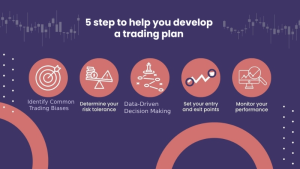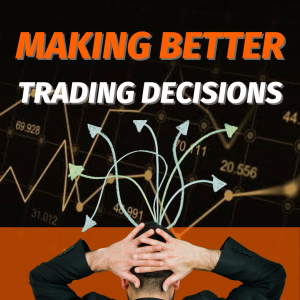Module 4: Cognitive Biases and Decision making
Understanding and managing cognitive biases such as over confidence, fear of loses and the tendency to anchor on initial information is more essential in trading to navigate markets effectively and to achieve success in the unpredictable trading market
Understanding Common Cognitive Biases
 Understanding cognitive biases like overconfidence and confirmation bias is crucial in trading psychology as these biases can significantly impact decision-making. Overconfidence leads traders to believe they have more knowledge or skill than they actually do, leading to excessive risk-taking or ignoring contrary evidence. Confirmation bias, on the other hand, causes traders to seek out information that confirms their pre-existing beliefs while disregarding conflicting data, which can distort their perception of market trends and potential outcomes.They can influence your decision making and lead you to subjectively wrong investment decisions .By recognizing these biases, traders can actively challenge their assumptions, seek diverse viewpoints, and adopt a more balanced approach to decision-making. This self-awareness helps mitigate the risks associated with biased thinking, fostering a more disciplined and objective approach to trading that enhances long-term success in financial markets.
Understanding cognitive biases like overconfidence and confirmation bias is crucial in trading psychology as these biases can significantly impact decision-making. Overconfidence leads traders to believe they have more knowledge or skill than they actually do, leading to excessive risk-taking or ignoring contrary evidence. Confirmation bias, on the other hand, causes traders to seek out information that confirms their pre-existing beliefs while disregarding conflicting data, which can distort their perception of market trends and potential outcomes.They can influence your decision making and lead you to subjectively wrong investment decisions .By recognizing these biases, traders can actively challenge their assumptions, seek diverse viewpoints, and adopt a more balanced approach to decision-making. This self-awareness helps mitigate the risks associated with biased thinking, fostering a more disciplined and objective approach to trading that enhances long-term success in financial markets.
Strategies to mitigate biases
 Developing bias mitigation strategies in your trading plan is crucial for achieving consistent success in financial markets. Biases, such as overconfidence, confirmation bias, and anchoring, can significantly impact your trading decisions and lead to poor performance. Implementing effective bias mitigation techniques helps you make more objective and data-driven decisions.
Developing bias mitigation strategies in your trading plan is crucial for achieving consistent success in financial markets. Biases, such as overconfidence, confirmation bias, and anchoring, can significantly impact your trading decisions and lead to poor performance. Implementing effective bias mitigation techniques helps you make more objective and data-driven decisions.
1. Identify Common Trading Biases: Start by recognizing common biases that can affect trading, such as loss aversion, recency bias, and herd mentality. Understanding these biases will help you create strategies to counteract them.
2. Detrmine your risk management: A well-defined trading plan outlines your entry and exit criteria, risk management strategies, and performance evaluation metrics. Effective risk management in trading psychology revolves around maintaining emotional discipline and adopting systematic strategies. Traders should establish clear risk limits, such as setting stop-loss orders and adhering to a predetermined percentage of capital to risk per trade. Maintaining a trading journal can help in analyzing past decisions, refining strategies, and recognizing emotional triggers. Regular self-assessment and mindfulness practices can also enhance emotional control, preventing impulsive decisions driven by fear or greed. By combining these approaches, traders can better manage risks and sustain long-term success. A well-defined trading plan outlines your entry and exit criteria, risk management strategies, and performance evaluation metrics.
3. Use Data-Driven Decision Making: Rely on quantitative analysis and historical data to guide your trading decisions. Implementing data-driven strategies helps minimize the influence of emotional biases and ensures your decisions are based on objective information.
4.Set your exit and entry points by implementing automated Trading Systems: Automated trading systems and algorithms can help reduce human biases by executing trades based on predefined criteria and market signals.Choosing a trading strategy using automated trading systems involves leveraging advanced algorithms to optimize decision-making and execution. Automated trading systems analyze vast amounts of market data at high speeds, identifying patterns and trends that might be missed by human traders. When selecting a strategy, it’s essential to choose one that aligns with your risk tolerance, trading goals, and market conditions. Backtesting is a critical step, as it evaluates how a strategy would have performed historically, helping to refine and adjust parameters for better future performance. Additionally, ongoing monitoring and adjustments are necessary to adapt to changing market dynamics and ensure the strategy remains effective. By integrating these automated tools, traders can enhance precision, reduce emotional bias, and improve overall trading efficiency.
5. Educate Yourself and monitor your performance Continuously: Stay informed about psychological biases and trading psychology through books, courses, and expert insights. Continuous learning and monitoring your performance from time to time helps you recognize and address biases more effectively.
By integrating these bias mitigation strategies into your trading plan, you enhance your ability to make rational, informed decisions and improve your overall trading performance.
Enhancing Decision making Skills
 Enhancing decision-making skills in trading psychology involves several key practices. First, developing a robust trading plan based on thorough research and analysis provides a structured framework for making informed decisions. Continuously educating oneself about market trends, economic indicators, and trading strategies enhances knowledge and confidence in decision-making. Practicing risk management techniques, such as setting stop-loss orders and diversifying investments, helps minimize potential losses and maintain a disciplined approach.
Enhancing decision-making skills in trading psychology involves several key practices. First, developing a robust trading plan based on thorough research and analysis provides a structured framework for making informed decisions. Continuously educating oneself about market trends, economic indicators, and trading strategies enhances knowledge and confidence in decision-making. Practicing risk management techniques, such as setting stop-loss orders and diversifying investments, helps minimize potential losses and maintain a disciplined approach.
Additionally, keeping a detailed trading journal allows for reflection on past decisions, identifying strengths and areas for improvement. Cultivating emotional resilience through mindfulness or relaxation techniques helps maintain a calm and focused mindset during volatile market conditions. Seeking feedback from experienced traders or mentors provides valuable insights and alternative perspectives, contributing to more well-rounded decision-making skills. Ultimately, by combining knowledge, discipline, emotional awareness, and continuous learning, traders can improve their ability to make effective decisions and navigate the complexities of financial markets successfully.
Module 1: Introduction to Trading Psychology

Module 2: Developing a Winning Mindset

Module 3: Emotional Regulation and Stress Management

Module 4: Cognitive Biases and Decision Making
Module 5: Creating a Personal Trading Plan
Module 6: Risk Management and Maintaining Balance
Module7:Overcomming Setbacks and building Resilience

Module 8:Continuous Improvement and Adaptations

Module 9: Advanced Psychological Strategies

Module 10:Case Studies and Real-life Applications
Module 11: Group Discussions and Peer Support
Module 12: Conclusion and Action Plan
Why choose us
Lorem ipsum dolor sit amet, consectetur adipiscing elit, sed do eiusmod tempor incididunt ut labore et dolore magna aliqua. Ut enim ad minim veniam
, quis nostrud exercitation ullamco laboris nisi ut aliquip ex ea commodo consequat. Duis aute irure dolor in reprehenderit in voluptate velit esse cillum dolore eu fugiat nulla pariatur.
Excepteur sint occaecat cupidatat non proident, sunt in culpa qui officia deserunt mollit anim id est laborum.Sed ut perspiciatis unde omnis iste natus error sit voluptatem accusantium doloremque laudantium
Lorem ipsum dolor sit amet, consectetur adipiscing elit, sed do eiusmod tempor incididunt ut labore et dolore magna aliqua. Ut enim ad minim veniam
Lorem Ipsum Dolor
Amet Sit Consecteture Lorem
Consectetur Adipiscing Elit.
Pellentesque In Ipsum Id Orci Porta Dapibus.
Sed Porttitor Lectus Nibh
We're Here To Help!
Office
San Francisco, CA 94143
Hours
S-S: Closed
